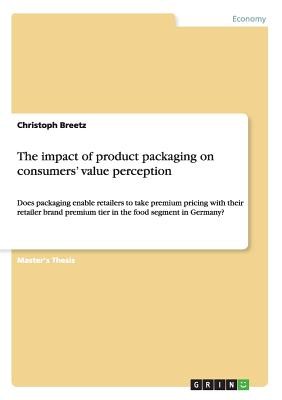
- We will send in 10–14 business days.
- Author: Christoph Breetz
- Publisher: GRIN Verlag
- Year: 2014
- Pages: 84
- ISBN-10: 3656570744
- ISBN-13: 9783656570745
- Format: 14.8 x 21 x 0.5 cm, softcover
- Language: English
- SAVE -10% with code: EXTRA
The impact of product packaging on consumers' value perception (e-book) (used book) | bookbook.eu
Reviews
Description
Master's Thesis from the year 2013 in the subject Business economics - Offline Marketing and Online Marketing, grade: 1.0, Durham University (Durham University Business School), course: MBA, language: English, abstract: This dissertation addresses the question of the impact of packaging to demand a price premium leveraging the example of retailer brand premium products in the food segment in Germany. Product tiering is a pricing structure that is commonly used by producers, in which consumers are segmented by willingness to pay for specific (added) product benefits. This is a way of maximizing utility for both consumers and producers, and is commonly already leveraged by producers of branded products, but lately also retailer brands, especially to enable growth outside the value tier. The role or packaging in the current literature is described as being a key influencer in the purchase decision making process, especially in-store. This research uses a survey across grocery purchase decision makers in Germany to identify the relationship of packaging and willingness to pay across a sample of retailer brand Tier 1, Tier 2 and Tier 3 products as well as a branded product in four different grocery categories (ham, cheese, jam and ice cream). Additionally five demographic factors such as e.g. age are collected. The intent is to answer whether i) packaging currently justifies the premium price of retailer brand tier 1 products compared to other product tiers, ii) packaging justifies the tier 1 retailer brand price premium, and iii) demographics influence the willingness to pay a premium price. Overall results indicate that the difference in packaging appeal can explain up to 35% of the willingness to pay for a retailer brand tier 1 product. However, results differ by grocery category and can't be easily generalized to the entire food segment, driven by the difference in perceived risk by the consumer. With regards to packaging as sole justification for the price the cons
EXTRA 10 % discount with code: EXTRA
The promotion ends in 18d.18:52:23
The discount code is valid when purchasing from 10 €. Discounts do not stack.
- Author: Christoph Breetz
- Publisher: GRIN Verlag
- Year: 2014
- Pages: 84
- ISBN-10: 3656570744
- ISBN-13: 9783656570745
- Format: 14.8 x 21 x 0.5 cm, softcover
- Language: English English
Master's Thesis from the year 2013 in the subject Business economics - Offline Marketing and Online Marketing, grade: 1.0, Durham University (Durham University Business School), course: MBA, language: English, abstract: This dissertation addresses the question of the impact of packaging to demand a price premium leveraging the example of retailer brand premium products in the food segment in Germany. Product tiering is a pricing structure that is commonly used by producers, in which consumers are segmented by willingness to pay for specific (added) product benefits. This is a way of maximizing utility for both consumers and producers, and is commonly already leveraged by producers of branded products, but lately also retailer brands, especially to enable growth outside the value tier. The role or packaging in the current literature is described as being a key influencer in the purchase decision making process, especially in-store. This research uses a survey across grocery purchase decision makers in Germany to identify the relationship of packaging and willingness to pay across a sample of retailer brand Tier 1, Tier 2 and Tier 3 products as well as a branded product in four different grocery categories (ham, cheese, jam and ice cream). Additionally five demographic factors such as e.g. age are collected. The intent is to answer whether i) packaging currently justifies the premium price of retailer brand tier 1 products compared to other product tiers, ii) packaging justifies the tier 1 retailer brand price premium, and iii) demographics influence the willingness to pay a premium price. Overall results indicate that the difference in packaging appeal can explain up to 35% of the willingness to pay for a retailer brand tier 1 product. However, results differ by grocery category and can't be easily generalized to the entire food segment, driven by the difference in perceived risk by the consumer. With regards to packaging as sole justification for the price the cons


Reviews